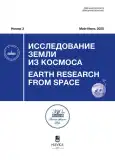Estimation of the precision of atmospheric phase delay models for displacement fields on Kamchatka region calculated by the differential interferometry method
- Authors: Volkova M.S.1, Mikhailov V.O.1, Osmanov R.S.1
-
Affiliations:
- Schmidt Institute of Physics of the Earth of the Russian Academy of Sciences
- Issue: No 3 (2025)
- Pages: 3-12
- Section: ФИЗИЧЕСКИЕ ОСНОВЫ ИССЛЕДОВАНИЯ ЗЕМЛИ ИЗ КОСМОСА
- URL: https://journals.eco-vector.com/0205-9614/article/view/693427
- DOI: https://doi.org/10.7868/S3034540525030014
- ID: 693427
Cite item
Abstract
The paper considers various ways of calculating atmospheric phase delays to correct the interferometric phase from which the displacements of the Earth’s surface are calculated by satellite radar interferometry methods. A local empirical weather model based on the empirical dependences of the physical properties of the atmosphere on altitude was constructed using data from Kamchatka meteorological stations, and electromagnetic signal propagation delays were calculated using this model. Further, the precision of the empirical weather model and the GACOS (Generic Atmospheric Corrections Online Service) model was assessed by comparing them with the delays calculated from the network of GNSS sites of the Kamchatka Branch of the Federal Research Center of “United Geophysical Service of RAS” (KB of UGS RAS) in the area of the Kliuchevskoi group of volcanoes. The results showed that for all precision assessment criteria, the GACOS model has lower error and better match with the GNSS data at the result comparison points. The relative residuals of the empirical model delays range from 0 to 5.7%, while for the GACOS delays the relative residuals do not exceed 1.6%. Meanwhile, for the GACOS and empirical weather models, on average, the relative residual is 0.3% and 0.9%, respectively, and the RMS errors are 0.6 cm and 2.3 cm. In general, at points of the locations of GNSS sites, a fairly good precision of calculations was obtained: the error is less than 1%, as well as a very high coefficient of determination of the dependencies of the compared models, almost corresponding to the correlation coefficient equal to 1. In addition, for 25% of the results, it is obtained that the empirical model outperforms the GACOS model, i.e., the delay values are closer to the delays calculated from the measurements at the GNSS sites. Since half of the weather stations and GNSS sites used to calculate the empirical weather model are local stations of the Kamchatka network that are not part of the global networks, the results obtained provide an independent assessment of the precision of corrections from the GACOS online service to the peninsula. The results of the study also show that the empirical atmospheric model constructed in this work provides good precision of calculations at GNSS point locations and their data allow us to calculate atmospheric delays for the Earth surface displacement fields obtained by satellite interferometry methods with high accuracy.
About the authors
M. S. Volkova
Schmidt Institute of Physics of the Earth of the Russian Academy of Sciences
Email: msvolkova6177@gmail.com
Moscow, Russia
V. O. Mikhailov
Schmidt Institute of Physics of the Earth of the Russian Academy of SciencesMoscow, Russia
R. S. Osmanov
Schmidt Institute of Physics of the Earth of the Russian Academy of SciencesMoscow, Russia
References
- Baby H.B., Golé P., and Lavergnat J. A model for the tropospheric excess path length of radio waves from surface meteorological measurements // Radio Sci. 1988. 23(6), 1023–1038. doi: 10.1029/RS023i006p01023.
- Delacourt C., Briole P., Achache J. Tropospheric corrections of SAR interferograms with strong topography: application to Etna // Geophysical Research Letters. 1998. V. 25. P. 2849‒2852.
- Doin M.-P., Lasserre C., Peltzer G., Cavalié O., & Doubre C. Corrections of stratified tropospheric delays in SAR interferometry: Validation with global atmospheric models // Journal of Applied Geophysics. 2009. 69(1), 35–50. DOI: 10.1016/ j.jappgeo.2009.03.010.
- Geng J., Chen X., Pan Y., Mao S., Li C., Zhou J., & Zhang K. PRIDE PPP-AR: an open-source software for GPS PPP ambiguity resolution // GPS Solutions, 2019. 23(4). doi: 10.1007/s10291-019-0888-1.
- Hanssen R.F.Radar Interferometry: Data Interpretation and Error Analysis. // Dordrecht: Kluwer Academic Publishers. 2001, 308 p.
- Smith E.K., Weintraub S. The constants in the equation for atmospheric refractive index at radio frequencies // Proc. I.R.E. 1953. 41, 1035–1037.
- Tetens O. 1930. Über einige meteorologische Begriffe. Z. Geophys 6: 297‒309.
- Volkova M.S., Mikhailov V.O., Osmanov R.S. Analysing the efficiency of the global weather model HRES (GACOS) for correction of atmospheric noise in interferometric estimates of displacement fields on the example of volcanoes in Kamchatka // Sovrem. Probl. Distantsionnogo Zondirovaniya Zemli iz Kosmosa 21 (2), 9–22 (2024).https://doi.org/10.21046/2070-7401-2024-21-2-9-22.
- Volkova M.S., Mikhailov V.O., Osmanov R.S.Comparison of atmospheric Corrections Models to satellite interferometry Data on Kamchatka Region // Issledovanie Zemli iz Kosmosa. 2025. № 3. P. 12–24.
- Yu C., Li Z., Penna N.T. Interferometric synthetic aperture radar atmospheric correction using a GPS-based iterative tropospheric decomposition model // Remote Sensing of Environment. 2017. V. 204. P. 109–121. DOI: 10.1016/ j.rse.2017.10.038.
- Yu C., Li Z., Penna N.T., Crippa P. Generic atmospheric correction model for interferometric synthetic aperture radar observations // J. Geophysical Research: Solid Earth. 2018. V. 123. P. 9202–9222.https://doi.org/10.1029/2017JB015305.
Supplementary files







